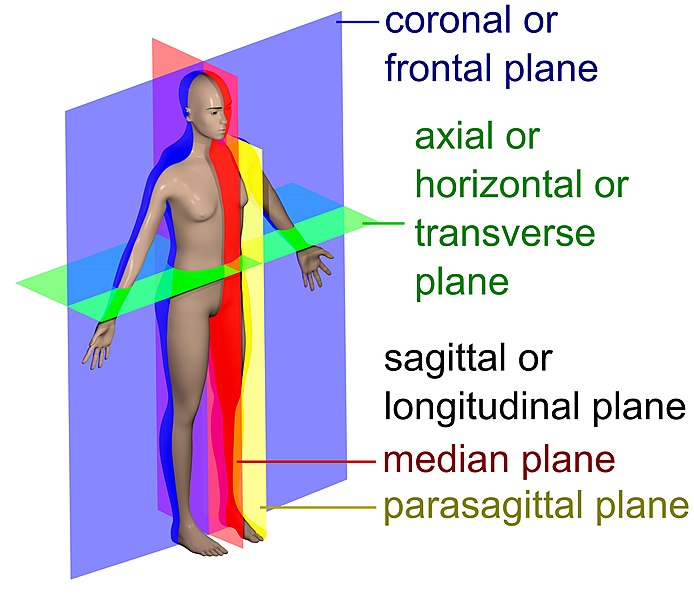Table of Contents
An anatomical plane refers to a hypothetical plane used in describing the location of bodily structures or movement directions. The three planes that are commonly used in human and animal anatomy are sagittal plane, coronal plane, and transverse plane.
Etymology
The term anatomical is a descriptive word that relates with anatomy, i.e. a branch of biology or medicine concerned with the shape, structure and the relationship of parts of organisms. It is derived from the Latin anatomicus or from the Ancient Greek ἀνατομία. These words might have come from ἀνά (aná), meaning “up” and τέμνω (témnō), meaning “I cut”. The term plane, in turn, came from the Latin plānum, meaning “flat surface”.
Types of anatomical planes

In animal and human anatomy, there are three major anatomical planes that are used in describing body planes and movement directions: (1) the sagittal plane (also called lateral plane or Y-Z plane, (2) coronal plane (also called frontal plane or Y-X plane), and (3) transverse plane (also called axial plane or X-Z plane).
Sagittal plane
The sagittal plane (also called lateral plane or Y-Z plane) is an anatomical plane that traverses the direction from top to bottom, resulting in left and right portions. There are two types: the median plane and the parasagittal plane.
Slicing across the midline would form the median plane, which is also referred to, in particular, as the mid-sagittal plane. Thus, a median plane is a type of sagittal plane that runs along the midline. Cutting the human body across the midline forms the median plane. Since the human body is bilaterally symmetrical, the left and right portions are similar morphologically.
Another type of sagittal plane is the parasagittal plane. It is the plane situated alongside or parallel to the mid-sagittal plane. Thus, it would refer to any plane traversing the direction from top to bottom but except for the midline as it would then be referred to as the median plane. For example, the midclavicular line crossing through the clavicle is a parasagittal plane.
Coronal plane
The coronal plane refers to any vertical plane resulting in posterior and anterior portions. In the human body, a cut from top to bottom at the sides results in the dorsal and frontal planes, e.g. back and belly.
Transverse plane
The transverse plane refers to any horizontal anatomical plane that runs through the midline of the body, thus, dividing the body into upper and lower halves. In the human body, it is perpendicular to the spine and results in superior and inferior portions.
See also
References
- 1.4D: Body Planes and Sections. (2018, July 18). Retrieved from Medicine LibreTexts website: https://med.libretexts.org/Bookshelves/Anatomy_and_Physiology/Book%3A_Anatomy_and_Physiology_(Boundless)/1%3A_Introduction_to_Anatomy_and_Physiology/1.4%3A_Mapping_the_Body/1.4D%3A_Body_Planes_and_Sections
Further readings
- Machine Design. (2015, February 2). What’s the Difference Between the Sagittal, Coronal, and Transverse Planes. Machine Design website: https://www.machinedesign.com/medical/what-s-difference-between-sagittal-coronal-and-transverse-planes
- The Anatomical Regions of the Body – dummies. (2017). Dummies website: https://www.dummies.com/education/science/anatomy/anatomical-regions-body/
© Biology Online. Content provided and moderated by Biology Online Editors







